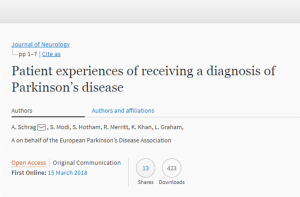 « Patient experiences of receiving a diagnosis of Parkinson’s disease » has been published in the Journal of Neurology. This work was supported in part by JPND through the CLaSP project, selected in the 2012 healthcare evaluation call.
« Patient experiences of receiving a diagnosis of Parkinson’s disease » has been published in the Journal of Neurology. This work was supported in part by JPND through the CLaSP project, selected in the 2012 healthcare evaluation call.
Author Archives: jpnd
Scientists have developed a novel approach for deep brain stimulation. The new method, published in Science, utilises upconversion nanoparticles to allow delivery of visible light deep into the brain to stimulate neural activities in a less-invasive manner. This innovation marks a significant breakthrough in optogenetics, empowering researchers to uncover valuable insights about the brain.
Optogenetics is a widely adopted research technique in the field of neuroscience that makes use of visible light to activate or inhibit neurons in the brain, enabling researchers to examine the brain’s functions in a minimally invasive manner. The inability of visible light to penetrate into deep brain structures, however, remains a major experimental challenge for this technique, and current deep brain stimulation still requires the insertion of an optical fibre directly into the brain.
To make deep brain stimulation less invasive, the researchers began exploring with near-infrared light, known to possess significantly higher tissue penetration capability and also relatively safe for biological samples. Using a two-step process, upconversion nanoparticles are first introduced into the brain by transcranial injection. Upon reaching deep brain, the implanted upconversion nanoparticles, a unique group of luminescent nanomaterials capable of converting near-infrared light into visible light, then generates visible light which acts to stimulate the neurons. The strategy has shown to be effective in triggering memory recall and dopamine release in the team’s experiments.
This novel approach offers a simpler, less-invasive alternative to fibre-optic implantation for deep brain stimulation, the researchers say, and holds immense potential in facilitating advancement in neuroscience.
Paper: “Near-infrared deep brain stimulation via upconversion nanoparticle–mediated optogenetics”
Reprinted from materials provided by the National University of Singapore.
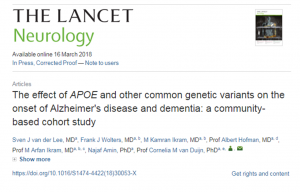 « The effect of APOE and other common genetic variants on the onset of Alzheimer’s disease and dementia: a community-based cohort study » has been accepted for publication in The Lancet Neurology. This work was supported in part by JPND through the PERADES project, selected in the 2012 risk factors call.
« The effect of APOE and other common genetic variants on the onset of Alzheimer’s disease and dementia: a community-based cohort study » has been accepted for publication in The Lancet Neurology. This work was supported in part by JPND through the PERADES project, selected in the 2012 risk factors call.
Higher levels of lifestyle physical activity — such as housecleaning, walking a dog and gardening, as well as exercise — are associated with more gray matter in the brains of older adults, according to a study published in The Journal of Gerontology: Psychological Sciences.
The gray matter in the brain includes regions responsible for controlling muscle movement, experiencing the senses, thinking and feeling, memory and speech and more. The amount of gray matter in the brain often begins to decrease in late adulthood, even before symptoms of cognitive dysfunction appear.
The study measured the levels of physical activity by 262 older adults. Participants wore a noninvasive device called an accelerometer continuously for seven to 10 days. The goal was to accurately measure the frequency, duration and intensity of a participant’s activities over that time.
The use of accelerometers was only one of the ways in which this analysis differed from some other investigations of the health of older people. Most research that explores the effects of exercise relies on questionnaires, which ask participants to « self-report » their levels of activity, the researchers said. Moreover, questionnaires tend to ask in a fairly non-specific fashion about types and intensity of exercise.
The study compared gray matter volumes as seen in participants’ MRIs with readings from the accelerometers and other data, which all were obtained during the same year. The analysis found the association between participants’ actual physical activity and gray matter volumes remained after further controlling for age, gender, education levels, body mass index and symptoms of depression, all of which are associated with lower levels of gray matter in the brain.
Article: “Accelerometer Physical Activity is Associated with Greater Gray Matter Volumes in Older Adults without Dementia or Mild Cognitive Impairment”
Reprinted from materials provided by Rush University Medical Center.
Scientists have transformed skin cells from patients with Huntington’s disease into the type of brain cell affected by the disorder, creating a new tool to study the degenerative and eventually fatal neurological condition.
The study, published in Nature Neuroscience, showed that the patients’ nerve cells — converted directly from patients’ skin cells — exhibited “symptoms” of the disorder, including DNA damage, dysfunctional mitochondria and cell death. Correcting for malfunctioning genes in these reprogrammed neurons prevented the cell death that is characteristic of Huntington’s disease, an inherited genetic disorder that causes cognitive decline and involuntary muscle movements.
Huntington’s disease and other inherited brain conditions are challenging to study because it is difficult to obtain samples of neurons from living patients. Seeking the next best thing, scientists have found ways to transform skin cells into brain cells.
Their method allows skin cells to bypass the stem cell stage as they are being reprogrammed into neurons. Passing through a stem cell stage resets the developmental clock to an embryonic-like state, wiping out the age-associated effects of the disorder. But the directly reprogrammed neurons retain their age, along with the problems associated with adult-onset Huntington’s disease, according to the researchers.
The researchers say that their technique, which allows them to capture characteristics of the disease at distinct moments in its progression, may also be applied to other conditions as well.
Paper: “Striatal neurons directly converted from Huntington’s disease patient fibroblasts recapitulate age-associated disease phenotypes”
Reprinted from materials provided by Washington University School of Medicine.
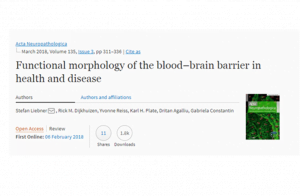 « Functional morphology of the blood–brain barrier in health and disease » has been published in Acta Neuropathologica. This work was supported in part by JPND through the SNOWBALL project, selected in the 2015 JPco-fuND call.
« Functional morphology of the blood–brain barrier in health and disease » has been published in Acta Neuropathologica. This work was supported in part by JPND through the SNOWBALL project, selected in the 2015 JPco-fuND call.
Doctors who work with individuals at risk of developing dementia have long suspected that patients who do not realize they experience memory problems are at greater risk of seeing their condition worsen in a short time frame, a suspicion that now has been confirmed in a new study.
Some brain conditions can interfere with a patient’s ability to understand they have a medical problem, a neurological disorder known as anosognosia often associated with Alzheimer’s disease. A study published in Neurology shows that individuals who experience this lack of awareness present a nearly threefold increase in likelihood of developing dementia within two years.
The researchers drew on data available through the Alzheimer’s Disease Neuroimaging Initiative (ADNI), a global research effort in which participating patients agree to complete a variety of imaging and clinical assessments. When a patient reported having no cognitive problems but the family member reported significant difficulties, he was considered to have poor awareness of illness.
Researchers then compared the poor awareness group to the ones showing no awareness problems and found that those suffering from anosognosia had impaired brain metabolic function and higher rates of amyloid deposition, a protein known to accumulate in the brains of Alzheimer’s disease patients.
A follow up two years later showed that patients who were unaware of their memory problems were more likely to have developed dementia, even when taking into account other factors like genetic risk, age, gender and education. The increased progression to dementia was mirrored by increased brain metabolic dysfunction in regions vulnerable to Alzheimer’s disease.
Article: “Anosognosia predicts default mode network hypometabolism and clinical progression to dementia”
Reprinted from materials provided by McGill University.
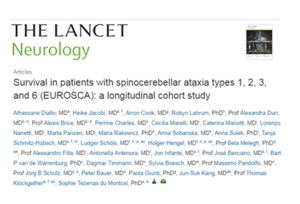 « Survival in patients with spinocerebellar ataxia types 1, 2, 3, and 6 (EUROSCA): a longitudinal cohort study » has been published in The Lancet Neurology. This work supported in part by JPND through the ESMI project, selected in the 2015 JPco-fuND call.
« Survival in patients with spinocerebellar ataxia types 1, 2, 3, and 6 (EUROSCA): a longitudinal cohort study » has been published in The Lancet Neurology. This work supported in part by JPND through the ESMI project, selected in the 2015 JPco-fuND call.
Amyloid beta pathology might have been transmitted by contaminated neurosurgical instruments, a new study published in Acta Neuropathologica suggests.
Researchers studied the medical records of four people who had brain bleeds caused by amyloid beta build-up in the blood vessels of the brain. They found that all four people had undergone neurosurgery two or three decades earlier as children or teenagers, raising the possibility that amyloid beta deposition may be transmissible through neurosurgical instruments in a similar way to prion proteins which are implicated in prion dementias such as Creutzfeldt-Jakob disease.
Amyloid beta is best known for being one of the hallmark proteins of Alzheimer’s disease, but the researchers did not find evidence of Alzheimer’s in this study.
A separate review of the medical literature supported the discovery by identifying four other case studies with similar pathology and past surgical history. As these patients were all men with a history of head trauma, research teams had previously speculated that those were correlated.
The new study suggests otherwise, as all patients had a history of childhood neurosurgery, three were women and only one had a history of head trauma.
In a comparison group of 50 people of similar ages from the same archives, the researchers did not find any amyloid beta pathology and only three had a recorded history of childhood neurosurgery.
Previous work in laboratory animals has shown that tiny amounts of abnormal amyloid beta protein can stick to steel wires and transmit pathology into the animals’ brains, but this paper is the first to suggest the same may be possible in humans.
Paper: “Evidence of amyloid-β cerebral amyloid angiopathy transmission through neurosurgery”
Reprinted from materials provided by UCL.
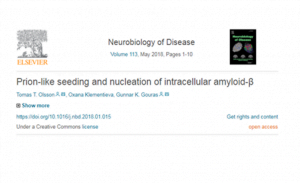 « Prion-like seeding and nucleation of intracellular amyloid-β » has been accepted for publication in Neurobiology of Disease. This work was supported in part by JPND through the DEMTEST project, selected in the 2011 biomarkers call.
« Prion-like seeding and nucleation of intracellular amyloid-β » has been accepted for publication in Neurobiology of Disease. This work was supported in part by JPND through the DEMTEST project, selected in the 2011 biomarkers call.
